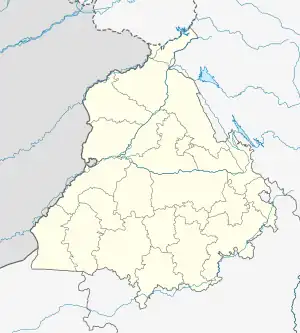Abohar | |
|---|---|
City | |
 Abohar Location in Punjab, India  Abohar Abohar (India) | |
| Coordinates: 30°08′00″N 74°12′00″E / 30.1334°N 74.2001°E | |
| Country | |
| State | Punjab |
| District | Fazilka |
| Government | |
| • Type | Municipal Corporation |
| • Body | Abohar Municipal Corporation |
| Area | |
| • Total | 188.24 km2 (72.68 sq mi) |
| Elevation | 180 m (590 ft) |
| Population (2011)[1] | |
| • Total | 145,302 |
| • Density | 770/km2 (2,000/sq mi) |
| Demonym | Aboharias |
| Languages | |
| • Official | Punjabi[2] |
| • Others | Bagri, Hindi[3] |
| Time zone | UTC+5:30 (IST) |
| PIN | 152116 |
| STD code | 01634 |
| Vehicle registration | PB-15 |
Abohar is a city and municipal corporation in the Fazilka district of the Indian state of Punjab,[4] southeast of Fazilka city and northeast of Sri Ganganagar.[5] It is near the India-Pakistan border. Abohar's population is 145,302 as of 2011.[6] The city is known for kinnow production and accounts for 60% of the country's produce.[7]
Demographics
Population
According to the 2011 Indian census, Abohar city had a population of 145,302, of which 76,984 were males and 68,318 were females.[1]
Religion
Majority of the people living in Abohar follows Hinduism, with a significant Sikh minority.[1]
Languages
Punjabi is the official language of the city and is spoken by the majority.[2][3] Other major languages spoken are Bagri and Hindi.[3]
Wildlife sanctuary
Abohar is home to the Abohar Wildlife Sanctuary, which provides a free-range sanctuary for black bucks. The open sanctuary is spread over an area of 18,650 hectares across farmlands and villages.[8] The Abohar Wildlife Sanctuary is located in the Fazilka District of Punjab. The formation of sanctuary relates to a unique success story of wildlife conservation in which people of Bishnoi community united themselves for protecting the Black Buck which is regarded as a sacred animal by them. It is also the State Animal of Punjab. It is home to several varieties of flora and fauna viz. Albizia lebbeck, Acacia nilotica, Azadirachta indica, A. tortilis, Nilgai, porcupine, hare, jackal, etc.
References
- 1 2 3 4 "C-01: Population by religious community - Abohar city". censusindia.gov.in. Retrieved 15 June 2022.
- 1 2 "52nd Report of the Commissioner for Linguistic Minorities in India" (PDF). nclm.nic.in. Ministry of Minority Affairs. Archived from the original (PDF) on 25 May 2017. Retrieved 8 August 2019.
- 1 2 3 4 "C-16: Population by mother tongue - Abohar". censusindia.gov.in. Retrieved 15 June 2022.
- ↑ "Municipal Council - Fazilka". fazilka.nic.in. Retrieved 21 August 2020.
- ↑ "Archived copy" (PDF). Archived from the original (PDF) on 9 November 2016. Retrieved 19 November 2016.
{{cite web}}: CS1 maint: archived copy as title (link) - ↑ "Census India 2011". Office of the Registrar General and Census Commissioner; India. Retrieved 1 January 2017.
- ↑ Kamal, Neel (2 March 2019). "Punjab: Good kinnow crop this year, but salinity poses a challenge". The Times of India. Retrieved 14 February 2020.
- ↑ "Black Buck Sanctuary Abohar | District Fazilka, Government of Punjab | India". fazilka.nic.in. Retrieved 22 February 2021.
https://www.gktoday.in/question/the-abohar-wildlife-sanctuary-is-located-in-which